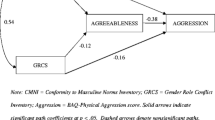Abstract
The present study examined the impact of gender role perceptions on ratings of aggressiveness. Male participants completed a laboratory aggression paradigm and were asked to rate the aggressiveness of their (bogus) opponent. Opponents were clearly identified as male or female and feminine or masculine. Further, all aggressive actions by the bogus opponent were standardized to be the same. Participants were significantly more likely to rate masculine opponents as aggressive, compared to feminine opponents, regardless of the gender of the opponent. These results imply that the subjective perception of aggression from others appears to be more strongly influenced by the gender role, rather than gender, of an aggressor.

Similar content being viewed by others
Notes
The BSRI items regarding competitiveness and aggressiveness were removed from the questionnaire to prevent the participants from forming opinions about competitiveness and/or aggressiveness prior to completing the reaction-time task.
References
Baron, R. A., & Richardson, D. R. (1994). Human aggression. New York: Plenum.
Bem, S. L. (1974). The measurement of psychological androgyny. Journal of Consulting and Clinical Psychology, 42, 155–162.
Bjorkqvist, K. (1994). Sex difference in physical, verbal and indirect aggression: a review of recent research. Sex Roles, 30(3–4), 177–188.
Bushman, B. J., Baumeister, R. F., & Phillips, C. M. (2001). Do people aggress to improve their mood? Catharsis beliefs, affect regulation opportunity, and aggressive responding. Journal of Personality and Social Psychology, 81, 17–32.
Franklin, K. (2000). Antigay behaviors among young adults. Journal of Interpersonal Violence, 15, 339–362.
Hammock, G. S., & Richardson, D. S. (1992). Predictors of aggressive behavior. Aggressive Behavior, 18, 219–229.
Harris, M. B. (1995). Ethnicity, gender and evaluations of aggression. Aggressive Behavior, 21(5), 343–357.
Lyons, J. A., & Serbin, L. A. (1986). Observer bias in scoring boys’ and girls’ aggression. Sex Roles, 14(5–6), 301–313.
Parrott, D. J., & Zeichner, A. (2003). Effects of hypermasculinity on physical aggression against women. Psychology of Men & Masculinity, 4(1), 70–78.
Pleck, J. (1995). The gender role strain paradigm: An update. In R. Levant & W. Pollack (Eds.), A new psychology of men (pp. 11–32). New York: Basic Books.
Pleck, J. H., Sonenstein, F. L., & Ku, L. C. (1993). Masculinity ideology and its correlates. In S. Oskamp & M. Constanzo (Eds.), Gender issues in social psychology (pp. 85–110). Newbury Park: Sage.
Reidy, D. E., Shirk, S. D., Sloan, C. A., & Zeichner, A. (2009). Men who aggress against women: effects of feminine gender role violation on physical aggression in hypermasculine men. Psychology of Men & Masculinity, 10(1), 1–12.
Richardson, D. S., & Green, L. R. (1999). Social sanction and threat explanations of gender effects of direct and indirect aggression. Aggressive Behavior, 25, 425–434.
Richardson, D. S., & Hammock, G. S. (2007). Social context of human aggression: are we paying too much attention to gender? Aggression and Violent Behavior, 12, 417–426.
Spence, J. T., & Helmreich, R. L. (1978). Masculinity and Femininity: Their psychological dimensions, correlates, and antecedents. Austin: University of Texas Press.
Stewart-Williams, S. (2002). Gender, the perception of aggression, and the overestimation of gender bias. Sex Roles, 46(5/6), 177–189.
Taylor, S. P. (1967). Aggressive behavior and physiological arousal as a function of provocation and the tendency to inhibit aggression. Journal of Personality, 35, 297–310.
Author information
Authors and Affiliations
Corresponding author
Appendix
Appendix
Additional Questions on BSRI Questionnaire and Standardized Answers
-
1.
What are your career goals?
Masculine: At this point I’d like to do corporate law; ultimately, I’d like to be a partner in a large firm.
Feminine: I really like working with people and making them feel better. I am at UND to get my Nursing degree. I hope to be an R.N. after I graduate.
-
2.
How important is it for you to be monogamous in relationships?
Masculine: While I think two people in a committed relationship should be monogamous, I don’t really see the point of committed relationships. I think people should just have fun, especially in college.
Feminine: I value monogamy very much. I think if two people (women or men) agree to be in a relationship, they should remain faithful to each other.
-
3.
How long does it usually take you to get ready in the morning? How important is it to you to always look your best?
Masculine: I usually only take a few minutes to get ready in the morning. I like to look good, but I don’t see the point of spending a lot of time to sit in class all day.
Feminine: I always get up at least two hours before I have to be anywhere so that I can take a shower and carefully pick out my outfit for the day. I like to always look my best.
-
4.
If your best friend were asked to describe you in three words, what would he/she say?
Masculine: Stubborn, Pushy, Non-traditional
Feminine: Gentle, Understanding, Kind
Rights and permissions
About this article
Cite this article
Borhart, H.M., Terrell, H.K. Perceptions of Aggression are Colored by Gender Roles. Psychol Rec 64, 441–445 (2014). https://doi.org/10.1007/s40732-014-0048-5
Published:
Issue Date:
DOI: https://doi.org/10.1007/s40732-014-0048-5




